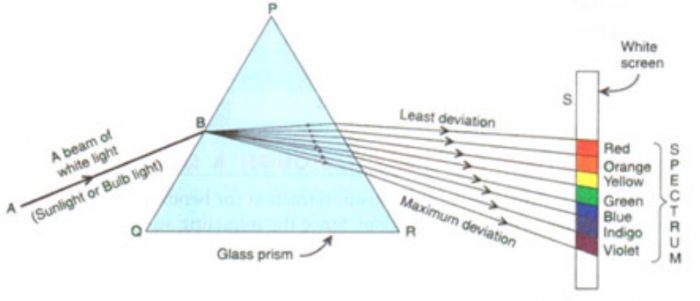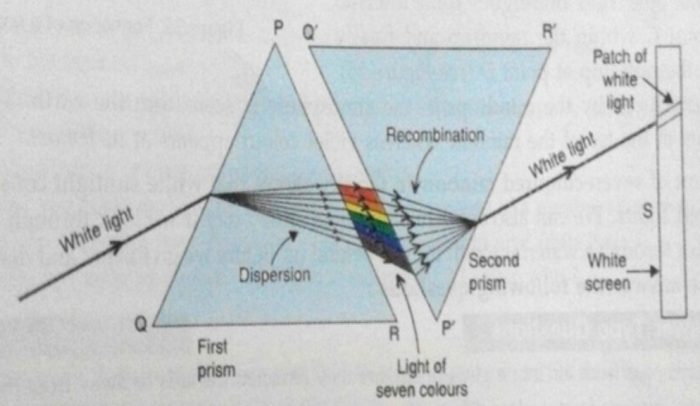Glass Prism
In a rectangular glass slab, the emergent light rays are parallel to the incident light rays because the opposite faces of a rectangular glass slab (where refraction takes place) are parallel to one another.
The triangular glass prism is a transparent object made of glass having two triangular ends and three rectangular sides (or rectangular faces).The opposite faces of a triangular glass prism are not parallel to one another.
They are inclined at an angle to one another.The angle between its opposite faces is called the angle of the prism.
For the sake of convenience in drawing ray-diagrams, a triangular glass prism is represented by drawing a triangle. A triangular glass prism is usually called glass prism.
In refraction through a glass slab, the emergent ray is parallel to the incident ray but in refraction through a glass prism, the emergent ray is not parallel to the incident ray because the opposite faces of the glass prism (where refraction takes place) are not parallel to one another. In refraction through a glass prism, the emergent ray is deviated from its original direction by a certain angle.
Refraction of light through a Glass Prism

When a ray of light passes through a glass prism, refraction (or bending) of light occurs both, when it enters the prism as well as when it leaves the prism. Since the refracting surfaces (PQ and PR) of the prism are not parallel, therefore, the emergent ray and incident ray are not parallel to one another.
(1) A glass prism PQR has been kept on its base QR.
(2) A ray of light AB is incident on the face PQ of the prism. The incident ray AB is going from air (rarer medium) into glass (denser medium), so it bends towards the normal BN’ and goes along the direction BC inside the glass prism. Thus, BC is the refracted ray of light which bends towards the base QR of the prism.
(3) When the ray of light BC travelling in the glass prism comes out into air at point C, refraction takes place again. Since the ray BC is going from glass (denser medium) into air (rarer medium), so it bends away from the normal MC and goes along the direction CD in the form of emergent ray.
(4) The emergent ray of light CD bends towards the base QR of the prism. When a ray of light passes through a prism, it bends towards the base of prism.
The angle between incident ray and emergent ray is called angle of deviation. The angle EOD is the angle of deviation. It is the peculiar shape (triangular shape) of the glass prism which makes the emergent ray bend with respect to the incident ray.
Dispersion of light

If a beam of white light is passed through a triangular glass prism, the white light splits to form a band of seven colours on a white screen.
The band of seven colours formed on a white screen, when a beam of white light is passed through a glass prism, is called spectrum of white light. The seven colours of the spectrum are Red, Orange, Yellow, Green, Blue, Indigo, and Violet. The seven colours of the spectrum can be denoted by the word VIBGYOR where V stands for Violet, I for Indigo, B for Blue, G for Green, Y for Yellow, for Orange and R for Red.
The splitting up of white light into seven colours on passing through a transparent medium like a glass prism is called dispersion of light.
White light is a mixture of seven colours (or seven coloured lights). The effect of glass prism is only to separate the seven colours of white light. A similar band of seven colours is produced when a beam of white light from an electric bulb falls on a triangular glass prism.
The dispersion of white light occurs because colours of white light travel at different speeds through the glass prism. The amount of refraction (or bending) depends on the speed of coloured light in glass. Now, since the different colours travel at different speeds, they are refracted (or bent) by different angles on passing through the glass prism (some colours are bent less whereas others are bent more).
When white light consisting of seven colours falls on a glass prism, each colour in it is refracted (or deviated) by a different angle, with the result that seven colours are spread out to form a spectrum.
The red colour has the maximum speed in glass prism, so the red colour is deviated the least. Due to this the red colour forms the upper part of the spectrum. The violet colour has the minimum speed in glass prism, so the violet colour is deviated the maximum. Due to this violet colour appears at the bottom of the spectrum. The seven colours of spectrum differ only in their frequencies. These colours in the order of increasing frequency (but decreasing wavelengths) are: Red, Orange, Yellow Green, Blue, Indigo and Violet.
Re-Combination of Spectrum Colours to Give White Light

The seven coloured lights of the spectrum can be recombined to give back white light.
A triangular glass prism POR is placed on its base QR, and another similar prism P’Q’R’ is placed alongside it in the inverted position on its vertex P’ so that its refracting surface is in opposite direction. When a beam of white light is allowed to fall on the first prism PQR, then a patch of ordinary white light is obtained on a screen S placed behind the second prism P’Q’R’.
The first glass prism PQR disperses (splits) the white light into seven coloured rays. The second glass prism P’Q’R“ receives all the seven coloured rays from the first prism and recombines them into original white beam of light which falls on the screen S. The recombination of seven colours, produced by first prism, is due to the fact that the second prism has been placed in reversed position due to which the refraction produced by the second prism is equal and opposite to that produced by the first prism

No comments:
Post a Comment